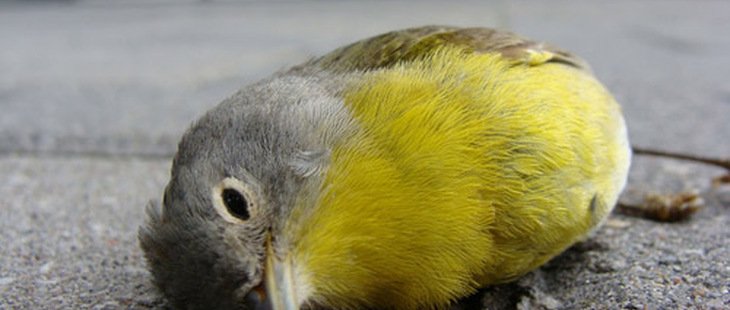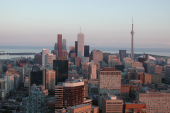
 (Photos: Sara Scharf)
(Photos: Sara Scharf)
It’s just after dawn and coral sunshine crests across the corridors of Toronto’s financial district, reflecting off the skyscrapers’ mirrored surfaces. The streets are empty, apart from the odd jogger, an eager-beaver banker or two. And a curious group of individuals clad in foul-weather gear and brandishing butterfly nets. These men and women look left and right, as if they might have lost something. They occasionally stop, look up, then carry on.
These people do not work for some strange branch of the city, but are rather the volunteer members of the Fatal Light Awareness Program, or FLAP. FLAP’s a charitable organization that collects dead or injured migratory birds that have either collided with buildings or become so exhausted by the light and reflections in this maze of towers that they’ve fallen to the streets below. For those birds still alive, the volunteers must race against the gulls that will swiftly dive in for the kill. Between one and ten million birds die every year in Toronto alone, simply by flying into windows.
Michael Mesure, the founder of FLAP, has joined me on this fresh early April morning. An artist and former gallery owner, Mesure started drawing birds at an early age — long before he devoted his life to saving them. “It started back in 1989,” he says, “when a friend mentioned that birds were hitting buildings in the financial district at an alarming rate. I came downtown to investigate, opened my car door, and a bird fell dead right beside me. I was just horrified and, at the same time, strangely intrigued. Not long after that I was picking up over a hundred birds at a time.”
Since registering FLAP as a charity in April 1993, Mesure and his team of volunteers have been pressuring building owners and tenants to address the problem. But too often it’s proved difficult enough just opening a dialogue. FLAP recently partnered with the City of Toronto to help develop an educational campaign called Lights Out Toronto that encourages workers to turn off their lights when they leave the office.

Since many smaller species fly at night and navigate by the constellations, they are attracted to the illumination from skyscrapers. But fatalities also occur during the day as birds hop from tree to tree, foraging for insects, and mistake the reflection of the tree they’re perched on for another and fly towards the window.
“The tenants need to be aware that there are two issues here,” Mesure says. “Lights being left on at night, and the reflective surfaces during the day. They’re addressing the nighttime strikes, but more bird deaths actually occur during the day. Tenants need to go to their management and demand some solutions to these day time strikes.” Statistics show that trees in the financial core often stand between 12 and 16 metres high. By applying visual markers at that height above ground level — these collisions could be avoided. Many owners resist, however, claiming such markers mar their buildings’ original design. Mesure’s goal is to convince owners there are visual markers that are both financially and aesthetically appealing.
We head over to the Toronto Dominion Centre and the TD Linkway, a low-level glass structure on Wellington Street that ranks third among the top 30 most lethal structures in Toronto (numbers one and two are 100 and 200 Consilium Place at Highway 401 and McCowan Road). Between black office towers, the collection of trees and flowerbeds make it a popular spot for a take-out lunch or a quick cigarette break. Mesure strides ahead and touches the glass with his hand. “If you look closely, you’ll notice they’ve adhered to inside of the window, a black spotted film designed to alert birds to the presence of glass. In order for this visual marker to have the full effect, you must apply the film to the outside surface of the glass. They’ve chosen to apply the film to the inside surface because more durable exterior films are more costly.” Mesure sees the application of visual markers as an opportunity for the building owners to enhance the appearance of their buiilding, while making a beneficial gesture towards the environment. “I always say, look at your windows like a canvas and go to town. But it all comes down to how serious people take this issue. Birds are intrinsically beneficial to all of us, eating billions of insects a year, dispersing countless seeds and pollinating millions of flowers. We’re obliged to do something.”

FLAP volunteer Dr. Sara Scharf fondly recounts hearing the orchestra of whitethroat sparrow calls echoing in the quiet and misty financial district at four in the morning. But she has many other, less enchanting, memories. “One of the hardest things is seeing live songbirds being eaten by seagulls before I can cross the street to get them,” she says. “Seagulls know where little birds are likely to hit, and they’ll hang around those areas in the early morning. When a seagull sees an injured bird, it’ll throw it up in the air and then swallow it head down, like a fish.” Birds found alive are often suffering from head trauma. Dr. Scharf and her fellow volunteers treat the birds with arnica, a homeopathic stress reliever, before gently examining them. Some regain their composure and fly away, while others are sent to rehabilitation centres where they’re nursed back to health and later released far away from the city.
“There are those who find birds dropping from the sky a very traumatic experience,” Mesure says. “Our volunteers have to get over that and retain their motivating passion to help. The public reacts in various ways. Some might be sitting outside having lunch and a bird will fall beside them and they become upset. Others simply move to the next seat and detach themselves completely.” After an hour or so in Mesure’s company, I’m relieved to not see any more injured or dead birds myself. I may have killed pigeon, pheasants, ducks and turkeys in my time, all while hunting, but songbirds and migratory birds play on me, their morning chorus evoking memories of a childhood spent in rural southern England.
Scharf is concerned about the number of new highly reflective buildings going up near the waterfront, which will likely increase the number of bird strikes in the city. Mesure says that Toronto’s Green Standard, passed last year, makes it mandatory that new buildings include some sort of method to deter these accidents, be it decals or nets. There are now even awards handed out, such as those from the Building Owners and Managers Association. The majority of the owners of existing structures, however, ignore the pleas of FLAP and other organizations. As a result, some are being sued. Eco Justice and Ontario Nature are currently in court pursuing a private prosecution against the owners of Consilium Place. FLAP’s been called as a witness in the case and is presenting data that claims the building’s been responsible for the death and injury of at least 7,000 migratory birds in the last decade, many on endangered watch lists. The complainants argue that, since buying the property in 2006, the current owners and manager of the building have done nothing to mitigate bird strikes. More court dates are scheduled for May.

Caroline Schultz, Ontario Nature’s executive director, points out that Canada’s boreal forest is the most important breeding ground for songbirds in the Americas. Yet the songbird population here has declined by 50 per cent over the past 40 years. And across North America, nearly two hundred birds of all sorts die every minute in collisions with human-built structures. Still, Mesure feels that FLAP is on the cusp of making a difference. Its advocacy program has been expanded to New York, Chicago and Montreal, and birder groups in European cities are looking to develop similar preventative projects. Media awareness is growing, too. CBC’s The Nature of Things shot an episode about the issue and FLAP back in the 1990s.
“The director and cameraman came down to the financial district for five days and we didn’t see a single dead or injured bird,” Mesure remembers. “Then, on the last day, when David Suzuki turned up to do his bit, it finally rained with birds.”














